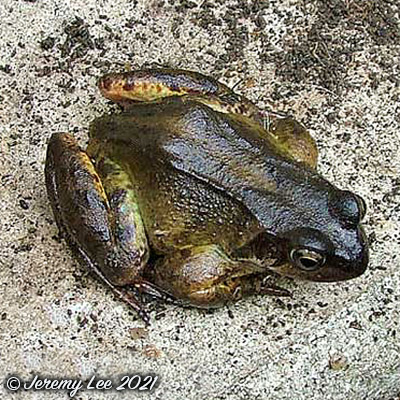
 |
|
Scientific Classifications explained » Amphibians » Ants » Aphids » Bees » Beetles » Birds » Bugs » Butterflies » Caterpillars » Damselflies » Dragonflies » Earwigs » Flies » Frog/Leafhoppers » Fungi » Galls » Grasshoppers » Harvestmen » Hoverflies » Lacewings » Ladybirds » Leaf Mines » Lichens » Mammals » Millipedes » Mosses » Moths » Sawflies » Slugs » Snails » Spiders » Trees & Shrubs » Wasps » Wild Flowers » Woodlice » Postboxes |
UK Nature > Amphibians > Rana temporaria

Scientific Name: Rana temporaria Common Name: Common Frog Up to 10cm long, the Common Frog (Rana temporaria) has an upperside whose ground colour ranges from very dark brown (such as specimen pictured here), through greyish-brown and olive green to yellow or even brick-red. Underside ranges from white to yellow, speckled with brown. The dark patches on the back vary, but there is always a dark patch, enclosing the eardrum, just behind the eye. The legs usually have dark transverse bands. There is a prominent skin fold on each side of the body. Eats slugs, worms, snails, and many other invertebrates on land, but doesn't feed in the water. Spends most of its time in damp places on land and moves to ponds and ditches to breed in Spring. Their gelatinous egg masses (frog spawn) give rise to tadpoles that turn into little frogs in about three months. Winter is passed in a dormant state, often in mud at the bottom of ponds. |
|

https://www.uknature.co.uk is a website dedicated to showing the immense diversity of UK nature and wildlife. Our vast range of habitats, from lowland arable to snow covered mountains, from storm-ravaged coastlines to peaceful inland freshwater lakes and rivers, from dry, sandy heaths to deciduous and coniferous forests, all these habitats contribute to the abundance of UK nature. We have wild birds in huge numbers either residing or visiting our shores (597 recorded species as at July 2013) and we must also not forget the humble back garden with its grass lawns, flower beds filled with nectar rich flowers, shrubs and trees, all designed to attract huge numbers of insects such as bees, moths, butterflies and hoverflies; and finally the small ponds which provide safe havens for frogs, toads, newts and even slow worms and grass snakes. www.uknature.co.uk is the showcase for my personal passion, photographing uknature in all its glory. I sincerely hope you all enjoy the fruits of my labours. This site and all images contained therein is © Jeremy Lee 2004 - 2025. All Rights Reserved. Site design by Jeremy Lee. Site development & IT Support by Stuart Lee. |